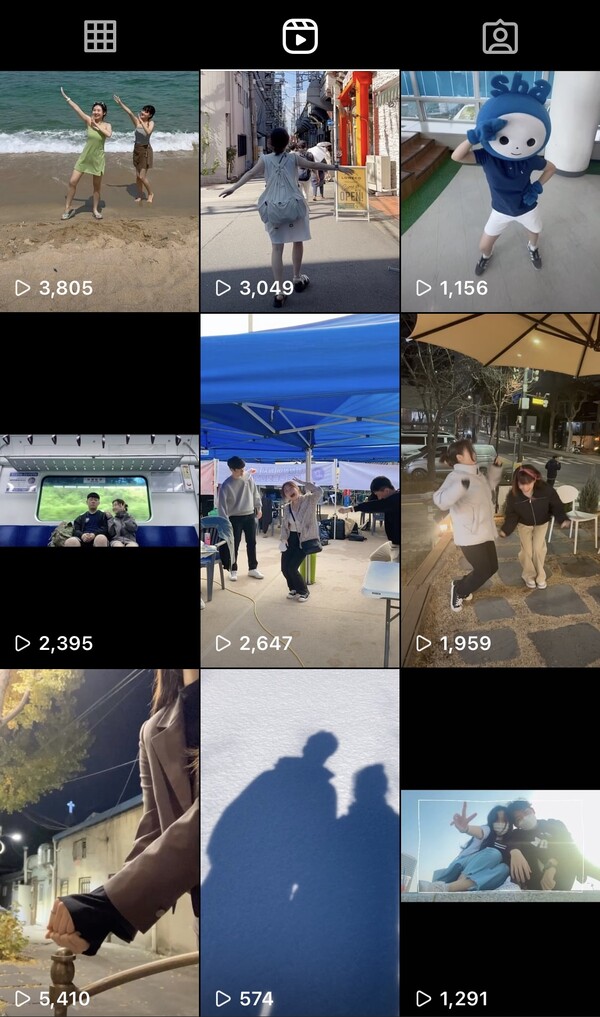
Short-form content and challenges lie at the heart of current digital communication trends.
Short-form content is now termed “snack culture,” offering a welcoming respite and entertainment amidst our busy daily routines. With the onset of a hyper-connected society, the short-form appeal is surging, letting us select any content anytime, anywhere. Furthermore, challenges within short-form content have risen above being just fleeting trends and are now recognized as cultural phenomena. Companies are using these challenges to grasp the attention of Generation Z (Gen Z), seizing the chance for dynamic brand interactions. The Dongguk Post will delve into the rise of short-form content, the emergence of challenge marketing, and cases that achieved heightened brand awareness.
The global inclination towards short-form content is a unique trend
The trend of short-form content is gaining popularity, especially among younger individuals. Short-form content pertains to videos created with a length between 15 seconds to 1 minute. This trend began to spread among Gen Z, a generation adept at using mobile devices. Leading platforms for short-form content include TikTok, YouTube Shorts, and Instagram Reels. While these videos are brief, often less than a minute, they encapsulate information, allowing users to comprehend content whenever and wherever swiftly. In its structure, short-form content breaks down the barriers established by traditional long-form content spanning various genres and media.
Conversely, the essence of marketing hinges on capturing people’s attention. By utilizing short-form videos with a lowered linguistic barrier, marketers can amplify consumer engagement more easily, positioning it as a potent instrument for global outreach. Distinct from conventional advertisements, short-form marketing boasts cost-efficiency and the capability for direct message conveyance. It can convey core messages effectively, making them a choice for many, due to their accessibility. It is perceived that short-form content has transcended its initial identity as brief videos to emerge as an influential media strategy that even bridges into commerce.
Short-form challenges are gaining popularity through participation
Short-form content emphasizes a user-centered participation culture. Examples can be shown through “TikTok,” a short-form video platform Social Network Service (SNS). TikTok is a platform where users create short videos and share them, forming a network with other users. Combining videos of other users with one’s own through “challenge” hashtags reveals its characteristics as a social media platform. Dance challenges, where users record and share their videos featuring various content, such as music, games, and movies, are prevalent. A representative example of dance challenge content is the “Any Song Challenge,” a participatory branding campaign on TikTok to market singer Zico’s single album, “Any Song.”
Challenge campaigns go beyond entertaining advertisements and engage users in branding, with participation becoming the content. In response, industries actively utilize challenge-style marketing to attract and engage Gen Z. Even if advertising messages are included, it becomes a powerful meme if the content is sufficiently captivating. The marketing of the fast-growing travel platform in Korea, “Yanolja,” could be an example. Yanolja’s 2022 summer season campaign, “#YanoljaSummer,” utilized a 2D sticker challenge. The challenge required participants to film a skit that matched a summer vacation concept determined by a random roulette. With a B-class (kitschy) charm, it succeeded with 17,000 challenge videos created in six days. Within a month, the views for the hashtag surpassed 100 million. The new paradigm of short-form content is active across various fields, garnering global resonance beyond language barriers. Hyundai Motor, an official 2022 Qatar World Cup partner, conducted a global short-form campaign in collaboration with TikTok. The dance challenge, named “#TeamCentury12,” invited participants to dance side by side. It also symbolizes unity by asking them to join as the 12th member of Team Century. In addition, the campaign, which also involved the renowned idol group BTS, accumulated more than 10 billion views. Likewise, challenges are eliciting viral attention.
Short-form challenges are having a significant impact in today’s society
One of the reasons for the popularity of short-form video challenges is, firstly, their entertainment value. The trend of short-form content, combined with the growth of social media, encourages more people to partake. Secondly, the driving force to follow the mainstream comes into play. Short-form content create a “bandwagon effect” where others want to join in trending, leading to large-scale interactions centered around keywords. Also, challenges satisfy one’s desire for self-expression. Social media platforms serve as tools for individuals to reveal their characteristics, interests, and thoughts. Lastly, motivation exists to participate in messages or objectives within a societal context. For instance, the “Thanks to Challenge” was used to express support for healthcare workers during the COVID-19 pandemic.
However, as various challenges increase and short-form content is exposed to all age groups, including children and teenagers, some say we should exercise caution to prevent dangerous trends from going viral. Amid this, a movement aims to utilize challenges’ positive influence. Challenges that encourage eco-friendly practices and better daily habits are becoming prevalent. For instance, many companies are hosting the “Plogging Challenge.” The term “Plogging” is a combination of the Swedish word “plocka upp,” which means “to pick up,” and the English word “jogging.” This challenge entails picking up trash while jogging. It began in Sweden in 2016 and is now recognized as a global fitness trend, gaining popularity. Participants are advised to carry trash bags, gloves, and pickers. The main goal of plogging is to collect as much litter from the streets as possible during a jog.
Short-form content and challenges aim to strengthen the connection between brands and consumers through content marketing and enhancing brand awareness. For the success of challenge marketing, it is essential to clearly define the ultimate marketing goal and plan challenges that align with that goal rather than just following them. It is necessary to accurately understand interests and characteristics of the target consumers and offer their desired content and benefits. Furthermore, planning simple and intuitive content for various users to participate in easily is recommended. Moreover, if meaningful challenges aiming at achieving various societal goals are well-established, it is expected to have a valuable influence across our daily lives.

